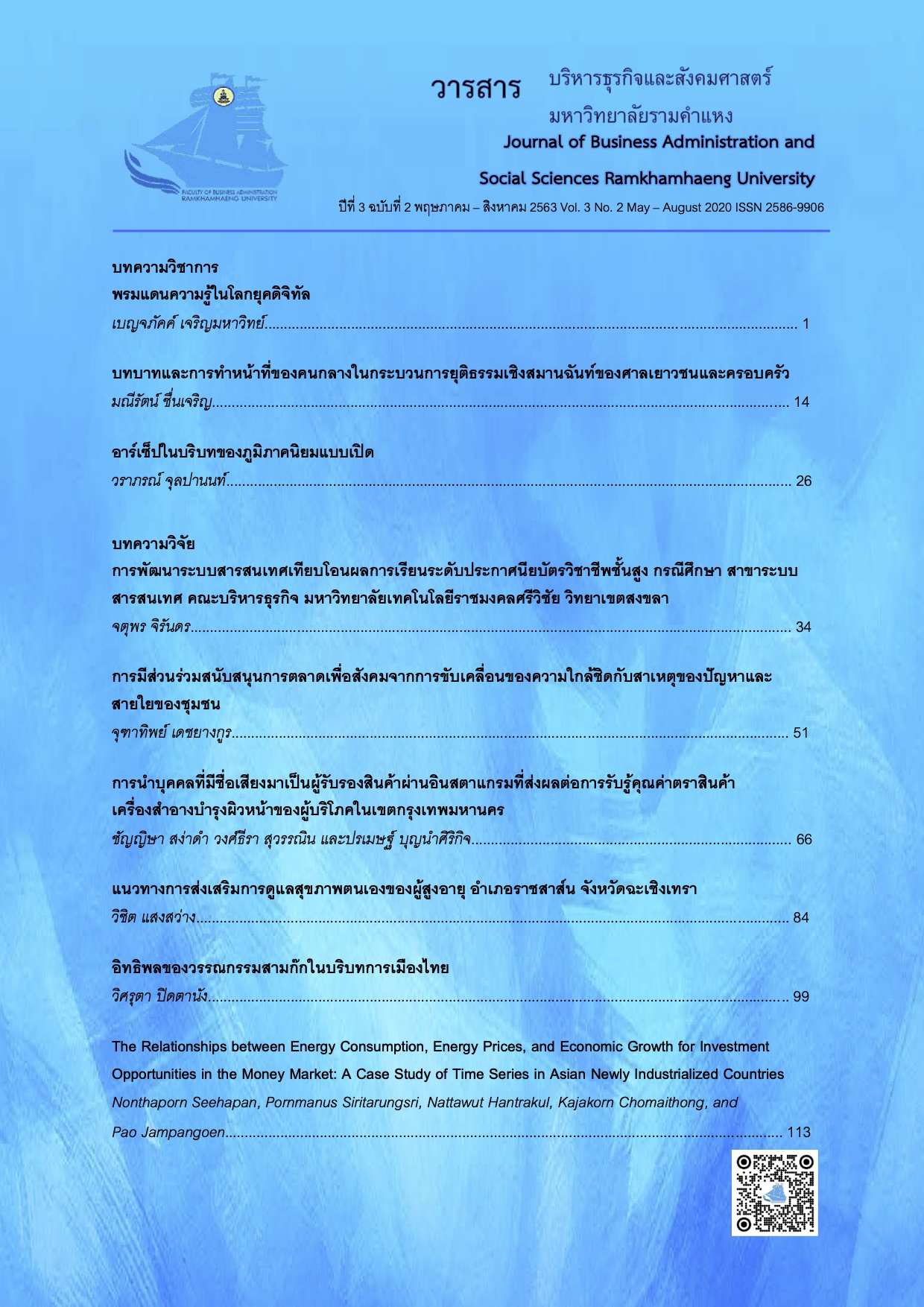การมีส่วนร่วมสนับสนุนการตลาดเพื่อสังคมจากการขับเคลื่อนของความใกล้ชิดกับสาเหตุของปัญหาและสายใยของชุมชน
Main Article Content
บทคัดย่อ
วัตถุประสงค์ของการวิจัยเพื่อ 1) ศึกษาระดับการรับรู้ของผู้บริโภคในการมีส่วนร่วมสนับสนุนการตลาดเพื่อสังคมจากการขับเคลื่อนของความใกล้ชิดกับสาเหตุของปัญหา สายใยของชุมชน การตระหนักรู้ ความรับผิดชอบร่วม และการมีส่วนร่วมในการสนับสนุนการตลาดเพื่อสังคม 2) ศึกษาอิทธิพลของบุพปัจจัย การรับรู้ของผู้บริโภคด้านความใกล้ชิดกับสาเหตุของปัญหาและสายใยของชุมชนที่ส่งผ่านการรับรู้ของผู้บริโภค ด้านการตระหนักรู้ ความรับผิดชอบร่วม นำไปสู่การมีส่วนร่วมในการสนับสนุนการตลาดเพื่อสังคม ผลการศึกษา พบว่า ระดับการรับรู้ของผู้บริโภคด้านปัจจัยความใกล้ชิดกับสาเหตุของปัญหาสิ่งแวดล้อม มีอิทธิพลรวมต่อการมีส่วนร่วมในการแก้ปัญหา สูงถึง 0.693 ในขณะที่การรับรู้ของผู้บริโภคด้านปัจจัยสายใยของชุมชนไม่มีอิทธิพลรวมต่อการมีส่วนร่วมในการแก้ปัญหา ซึ่งมีค่าเพียง 0.066 แสดงว่า กลุ่มตัวอย่างมีส่วนร่วมในการแก้ปัญหาสิ่งแวดล้อมเป็นรายเฉพาะตัวมากกว่าที่จะใช้ปัจจัยสายใยของชุมชนเข้ามาร่วมในการขับเคลื่อนการแก้ปัญหา ในส่วนของปัจจัยคั่นกลาง คือระดับการรับรู้ของผู้บริโภคด้านปัจจัยการตระหนักรู้ และปัจจัยความรับผิดชอบร่วม มีอิทธิพลต่อปัจจัยการมีส่วนร่วมในการแก้ปัญหา โดยพบว่าปัจจัยการตระหนักรู้ มีอิทธิพลสูงถึง 0.668 ส่วนปัจจัยความรับผิดชอบร่วม มีน้ำหนักอิทธิพล 0.343 ซึ่งทั้งสองปัจจัยคั่นกลางส่งผลต่อการมีส่วนร่วมในการแก้ปัญหาสิ่งแวดล้อมอย่างมีนัยสำคัญ
Article Details
เนื้อหาและข้อมูลในบทความที่ลงตีพิมพ์ในวารสารบริหารธุรกิจและสังคมศาสตร์ มหาวิทยาลัยรามคำแหง ถือเป็นข้อคิดเห็นและความรับผิดชอบของผู้เขียนบทความโดยตรง ซึ่งกองบรรณาธิการไม่จำเป็นต้องเห็นด้วย หรือร่วมรับผิดชอบใดๆ
บทความ ข้อมูล เนื้อหา รูปภาพ ฯลฯ ที่ได้รับการตีพิมพ์ในวารสารบริหารธุรกิจและสังคมศาสตร์ มหาวิทยาลัยรามคำแหง ถือเป็นลิขสิทธิ์ของวารสารบริหารธุรกิจและสังคมศาสตร์ มหาวิทยาลัยรามคำแหง หากบุคคลหรือหน่วยงานใดต้องการนำบทความทั้งหมดหรือส่วนหนึ่งส่วนใดไปเผยแพร่ต่อ หรือเพื่อกระทำการใดๆ จะต้องได้รับอนุญาตเป็นลายลักษณ์อักษรจากวารสารบริหารธุรกิจและสังคมศาสตร์ มหาวิทยาลัยรามคำแหง ก่อนเท่านั้น
References
Bagozzi, R. P., & Dholakia, U. M. (2006). Antecedents and purchase consequences of customer participation in small group brand communities. International Journal of Research in Marketing, 23(1), 45-61.
Benjamin, H., & Lagerlund, H. (2012). Suárez on self-awareness. New York: Oxford University.
Cone Roper, Inc. (2000). Cause-Related Teen Survey. Boston: MA, Cone lnc.
Good, C. V. (1973). Dictionary of education. New York: McGraw-Hill.
Hagel, J. III, & Armstrong, A. (1997). Net Gain. Boston. MA: Harvard Business School.
Hammad, H., El-Bassiouny, N., Paul, P., & Mukhopadhyay, K. (2014). Antecedents and consequences of consumers' attitudinal dispositions toward cause-related marketing in Egypt. Journal of Islamic Marketing, 5(3), 414-445.
Kim, H. S., Jin, Y. P., & Jin, B. (2007). Dimensions of online community attributes examination of online communities hosted by companies in Korea. International Journal of Retail & Distribution Management, 36(10), 101-120.
Kokoszka, A. (2014). States of Consciousness: Models for Psychology and Psychotherapy. New York: Springer Science+Business.
Kotler, P., & Lee, N. R. (2008). Social marketing: Influencing behaviors for good (3rd ed.). London (Sage).
Kotler, P., & Zaltman, G. (1971). Social marketing: An approach to planned social change. Journal of Marketing, 35(3), 3-12.
Liu, M. T., Wong, I. A., Shi, G., Chu, R., & Brock, J. L. (2014).The impact of corporate social responsibility (CSR) performance and perceived brand quality on customer-based brand preference. Journal of Services Marketing, 28(3), 181-194.
Mahamuni, A., & Tambe, M. (2014). Green marketing in automobile and ancillary industry: Issues and implications. Journal of Commerce & Management Thought, 5(3), 363-377.
Marin, L., Ruiz, S., & Rubio, A. (2009). The role of identity salience in the effects of corporate social responsibility on consumer behavior. Journal of Business Ethics, 84(1), 65-78.
Mattila, A. S., & Hanks, L. (2012). Antecedents to participation in corporate social responsibility Programs. Journal of Service Management, 23(5), 664-676.
No More Baggage. Org. (2012). Did you know how recent disposable bags were invented. Retrieved February 2, 2020, from http:/www.nomorebaggage.org
Porter, M. E., & Kramer, M. R. (2011). Creating shared value. Harvard Business Review, 89(1/2), 62-77.
Schermelleh-Engel, K., Moosbrugger, H., & Müller, H. (2003), Evaluating the fit of structural equation models: Tests of significance and descriptive goodness of-Fit measures. Methods of Psychological Research Online, 8(2), 23-74.
Tabachnick, B. G. & Fidell, L. S. (2007). Using multivariate statistics (5th ed.). New York: Allyn and Bacon.
Thai Health Promotion Foundation. (2011). Thailand and its daily 40,000 tons of waste. Retrieved January 31, 2020, from http://www.thaihealth.or.th
Vandenberg, R. J. (2006). Statistical and methodological myths and urban legends. Organizational Research Methods, 9(2), 194-201.
Varadarajan, P. R., & Menon, A. (1988). Cause-related marketing: A coalignment of marketing strategy and corporate philanthropy. The Journal of Marketing, 52(3), 58-74.
Wheaton, B., Muthen, B., Alwin, D. F., & Summers, G. (1977). Assessing reliability and stability in panel models. Sociological Methodology, 8(1), 84-136.
World Bank. (2010). The economics of adaptation to climate change. Washington, DC: World Bank.
World Business Council for Sustainable Development. (2006). From challenge to opportunity: The role of business in tomorrow’s society. Retrieved February 20, 2020, from https://www.globalhand.org/system/assets/1759c470b1dc6e588d98857733a9585b7bae9306/original/tomorrows-leaders.pdf?1315627402
